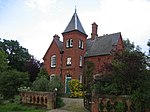Wroxall Abbey
Country houses in WarwickshireGrade II listed buildings in WarwickshireGrade II listed housesHistory of WarwickshireHouses completed in 1141

Wroxall Abbey is a substantial Victorian mansion house situated at Wroxall, Warwickshire which was converted for use as a hotel, spa, wedding venue and conference centre. It is a Grade II listed building.
Excerpt from the Wikipedia article Wroxall Abbey (License: CC BY-SA 3.0, Authors, Images).Wroxall Abbey
Birmingham Road,
Geographical coordinates (GPS) Address Nearby Places Show on map
Geographical coordinates (GPS)
| Latitude | Longitude |
|---|---|
| N 52.334 ° | E -1.6764 ° |
Address
Birmingham Road
CV35 7ND , Beausale, Haseley, Honiley and Wroxall
England, United Kingdom
Open on Google Maps









